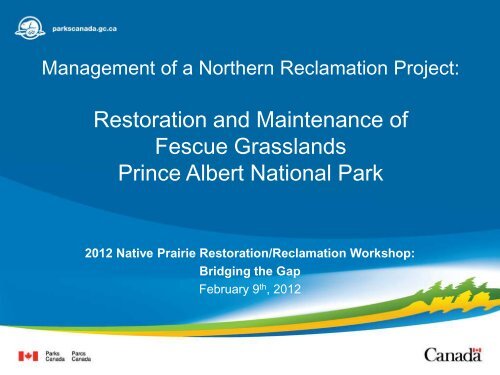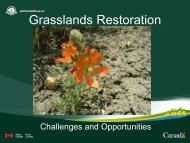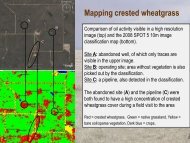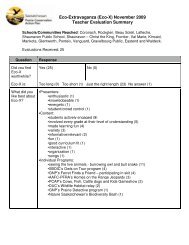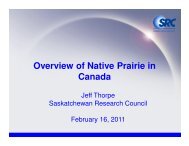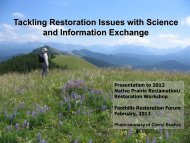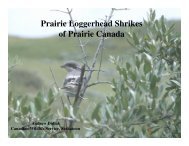Restoration and Maintenance of Fescue Grasslands Prince Albert ...
Restoration and Maintenance of Fescue Grasslands Prince Albert ...
Restoration and Maintenance of Fescue Grasslands Prince Albert ...
You also want an ePaper? Increase the reach of your titles
YUMPU automatically turns print PDFs into web optimized ePapers that Google loves.
Management <strong>of</strong> a Northern Reclamation Project:<strong>Restoration</strong> <strong>and</strong> <strong>Maintenance</strong> <strong>of</strong><strong>Fescue</strong> Grassl<strong>and</strong>s<strong>Prince</strong> <strong>Albert</strong> National Park2012 Native Prairie <strong>Restoration</strong>/Reclamation Workshop:Bridging the GapFebruary 9 th , 2012
Plains Rough <strong>Fescue</strong> (Festuca hallii)Grassl<strong>and</strong>s in Saskatchewan• Part <strong>of</strong> the aspen parkl<strong>and</strong>eco-region• Historic extent 255,000 ha• A dynamic mix <strong>of</strong> fescuegrassl<strong>and</strong>s <strong>and</strong> aspen groves• Evolved within a fire <strong>and</strong>grazing disturbance regime• Floristically diverse community(Gerry <strong>and</strong> Anderson, 2002)
Current Distribution in Saskatchewan• ~ 5% <strong>of</strong> the historic grassl<strong>and</strong>remains in Saskatchewan• 85 % <strong>of</strong> the remaining patchesare less than 65 ha in size– Small <strong>and</strong> highly fragmented• Ongoing threats to fescuegrassl<strong>and</strong>s:– Settlement– Cultivation– Lack <strong>of</strong> fire disturbance• encroachment <strong>of</strong> aspen– Invasive non-native plants– Overgrazing– Reduction in species richness <strong>and</strong>genetic isolation <strong>of</strong> remnant patches(Gerry <strong>and</strong> Anderson, 2002)
<strong>Fescue</strong> Grassl<strong>and</strong>s in <strong>Prince</strong> <strong>Albert</strong> NationalPark:• Northern outliers <strong>of</strong> contiguousaspen parkl<strong>and</strong> eco-region• Ongoing threats to fescuegrassl<strong>and</strong>s in PANP:– Lack <strong>of</strong> fire disturbance• Encroachment <strong>of</strong> aspen– Small <strong>and</strong> highly fragmented• Genetic isolation• Reduction in species richness• Potential for local extinctions– Invasive non-native plants• Disturbed sites• Trails <strong>and</strong> roadways– Lack <strong>of</strong> public underst<strong>and</strong>ing <strong>of</strong>the dynamic nature <strong>of</strong> nativegrassl<strong>and</strong>s
<strong>Fescue</strong> Grassl<strong>and</strong>s in PANP:Map shows the location <strong>of</strong> the 18 largest (12-115 ha) grassl<strong>and</strong>s.Many smaller patches are located in this area
<strong>Fescue</strong> Grassl<strong>and</strong>s in PANP:• Approximately 67% <strong>of</strong> thefescue grassl<strong>and</strong> in PANPwas overgrow by aspenforest from 1947 to 1995• 1968 extent ~670 ha• 2012 extent unknown• Currently:– Only “Core”grassl<strong>and</strong>s remain– “Seral” grassl<strong>and</strong>support mature forest(>50 years)Name <strong>of</strong>MeadowJonasson’sFlatsTwelve MileMeadowWasstrom’sFlatsSouth EndMeadowSugar CreekMeadowsAveragedecrease (%)1947 area(ha)1995 area(ha)Decrease inarea (%)95.0 40.6 57%9.5 5.4 43%239.5 46.2 80%79.9 16.0 80%88.5 20.1 77%67.4%
Wasstrom’s Flats
PANP - Restore <strong>and</strong> Maintain <strong>Fescue</strong>Grassl<strong>and</strong>s• <strong>Fescue</strong> Grassl<strong>and</strong> Management Plan for<strong>Prince</strong> <strong>Albert</strong> National ParkActions:• Re-introduce a representative fire regime to the area known tosupport fescue grassl<strong>and</strong>s – 40 year fire cycle• By 2025, restore select fescue grassl<strong>and</strong>s to between 50 <strong>and</strong> 100%<strong>of</strong> their 1947 distribution• Reclamation <strong>of</strong> disturbed sites within fescue grassl<strong>and</strong>s• Invasive non-native plant species control• Increase public awareness , underst<strong>and</strong>ing <strong>and</strong> appreciation <strong>of</strong>fescue grassl<strong>and</strong>s
<strong>Restoration</strong> <strong>of</strong> Disturbed Sites Within<strong>Fescue</strong> Grassl<strong>and</strong>s <strong>of</strong> PANP• Gravel pits are located in 12 Mile<strong>and</strong> South End grassl<strong>and</strong>s• No rehabilitation efforts havebeen made since extractionactivities ceased in 1977• Areas are now:– Sparsely vegetated with largepatches <strong>of</strong> bare ground– Support non-native plant species– Negatively impact the publicperception <strong>of</strong> natural areas
12 Mile Meadow <strong>Restoration</strong>Sturgeon Crossing Station• <strong>Restoration</strong> planwas completed in 2010• Area: 0.75 ha• Goals:– Remove the steep slopes <strong>and</strong>remaining topographic features– Eliminate non-native plantspecies <strong>and</strong> the potential forthem to spread into thesurrounding area12 Mile Meadow– Restore native vegetation2 km– Involvement <strong>of</strong> volunteers toengage the public <strong>and</strong> to createawareness <strong>of</strong> native prairieconservation
12 Mile Meadow <strong>Restoration</strong> - 2010• Initial Non-nativespecies control:– Identify species present• Smooth Brome• Yellow Toadflax• Kentucky Bluegrass– Application <strong>of</strong> Glyphosate inJuly 2010• Spray at 5% concentrationthroughout the pit• Wick at 20% concentrationalong edge <strong>and</strong> roadway
12 Mile Meadow <strong>Restoration</strong> - 2010Grading/Capping <strong>of</strong><strong>Restoration</strong> Site:• Grading to reduce slopes– Goal is to achieve slopes < 25%• Cap site with overburden• Occurred September 2010– Vegetation on overburden site wasfelled <strong>and</strong> mulched– Woodchips <strong>and</strong> stumps used as fill– Excavator <strong>and</strong> dozer to removesteep slopes <strong>and</strong> push overburden– Grader used to contour therestoration area
12 Mile Meadow <strong>Restoration</strong> - 2010Native Seed Collection:• H<strong>and</strong> held seed harvester– Collection <strong>of</strong> local grass <strong>and</strong> forbseed from grassl<strong>and</strong>s within thepark– Seed collected over severalweeks– ~30 kg <strong>of</strong> seed collected– Dried, sieved through screens,cold storage• Selective h<strong>and</strong> picking <strong>of</strong>fescue seed– Ensure <strong>of</strong> pure fescue seed– ~0.45 kg <strong>of</strong> seed collected– Contracted to greenhouse forstorage
12 Mile Meadow <strong>Restoration</strong> - 2011Seeding June 13-17 th :• Area harrowed• Broadcast seeding <strong>of</strong> nativeseed <strong>and</strong> chaff• Planting <strong>of</strong> fescue plugs– 8000 plugs grown (PRT <strong>Prince</strong> <strong>Albert</strong>)– 1 plug/m 2• Additional seeding Oct 18 th– Aid in native plant establishment– Compete against non-nativespecies– Reduce amount <strong>of</strong> bare ground
12 Mile Meadow <strong>Restoration</strong> - 2011• Volunteer Projects– <strong>Fescue</strong> plugs grown in <strong>of</strong>fices<strong>of</strong> park staff– Northl<strong>and</strong>s College studentsinvolvement• Irrigation– Use <strong>of</strong> fire pumps, hoses, <strong>and</strong>sprinklers– Water drawn from adjacentbeaver pond• Electric fence– Used to persuade wildlife toavoid area
12 Mile Meadow <strong>Restoration</strong> - 2011Monitoring:• The average slope is now 3.8%• Topsoil has average depth <strong>of</strong> 17.5 cm• Germination rates for native seed was low– Need higher amounts <strong>of</strong> clean seed• Plug establishment was high– Will monitor in spring 2012 for overwinter success• Vast improvement in the overall condition <strong>of</strong> the area– Contoured gentle slopes– Area capped with local topsoil– Establishment <strong>of</strong> native grasses <strong>and</strong> forbs
• Improvement in distribution– 15% decrease in the amount<strong>of</strong> monitoring plots withnon-natives found• Increase in non-nativespecies present– 4 species identified• Control Methods– Chemical control– Mowing12 Mile Meadow <strong>Restoration</strong>Non-Native Vegetation– Seeding <strong>of</strong> native species
Presence12 Mile Meadow <strong>Restoration</strong>Non-Native Vegetation100Percentage <strong>of</strong> Plots Containing Non-Native Species90807060PigweedD<strong>and</strong>elionRed CloverWhite Sweet CloverBlack Medic5040302010Canada ThistleAlsike CloverSow ThistleChickweedAlfalfaGreen Foxtail0Non-native Species
Trials <strong>and</strong> tribulations:• Logistics <strong>of</strong> getting to the remotelocation – travel time• Adverse weather conditions• Trail conditions• Time involved to do workload• Native seed establishment– Seed viability– Soil conditions – s<strong>and</strong>y/gravel• Dealing with Non-natives– Establishment– Introduction from equipment <strong>and</strong> in-fillfrom other areas• Patience12 Mile Meadow <strong>Restoration</strong>Discussion
12 Mile Meadow <strong>Restoration</strong>Moving Forward• Increase public awareness <strong>of</strong> thedynamic nature <strong>of</strong> native grassl<strong>and</strong>s• Continue with control <strong>of</strong> non-natives• Utilise the experience <strong>and</strong> monitoring<strong>of</strong> 12 Mile Meadow for futurerestoration projects– Use more native seed– Planting methods <strong>and</strong> equipment– Diligence in non-native species control
For more information :Please contact:Dustin GuedoFire/Vegetation Specialist<strong>Prince</strong> <strong>Albert</strong> National ParkBox 100Waskesiu Lake, Sk.S0J 0N0Phone: (306) 663-4544Email: dustin.guedo@pc.gc.ca


